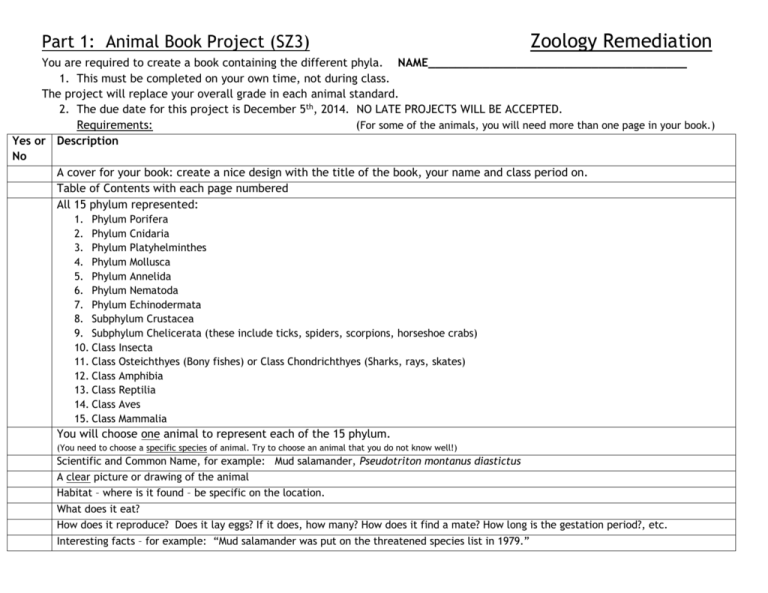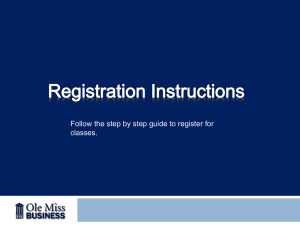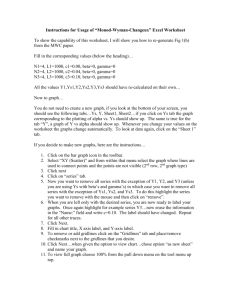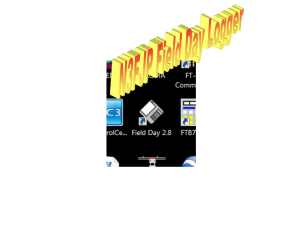Animal Book Project
advertisement

Part 1: Animal Book Project (SZ3) Zoology Remediation You are required to create a book containing the different phyla. NAME______________________________________ 1. This must be completed on your own time, not during class. The project will replace your overall grade in each animal standard. 2. The due date for this project is December 5th, 2014. NO LATE PROJECTS WILL BE ACCEPTED. Requirements: (For some of the animals, you will need more than one page in your book.) Yes or Description No A cover for your book: create a nice design with the title of the book, your name and class period on. Table of Contents with each page numbered All 15 phylum represented: 1. Phylum Porifera 2. Phylum Cnidaria 3. Phylum Platyhelminthes 4. Phylum Mollusca 5. Phylum Annelida 6. Phylum Nematoda 7. Phylum Echinodermata 8. Subphylum Crustacea 9. Subphylum Chelicerata (these include ticks, spiders, scorpions, horseshoe crabs) 10. Class Insecta 11. Class Osteichthyes (Bony fishes) or Class Chondrichthyes (Sharks, rays, skates) 12. Class Amphibia 13. Class Reptilia 14. Class Aves 15. Class Mammalia You will choose one animal to represent each of the 15 phylum. (You need to choose a specific species of animal. Try to choose an animal that you do not know well!) Scientific and Common Name, for example: Mud salamander, Pseudotriton montanus diastictus A clear picture or drawing of the animal Habitat – where is it found – be specific on the location. What does it eat? How does it reproduce? Does it lay eggs? If it does, how many? How does it find a mate? How long is the gestation period?, etc. Interesting facts – for example: “Mud salamander was put on the threatened species list in 1979.” Part 2: USATestPrep website: www.usatestprep.com Account ID: southcobb Activation Code: stu1564 You create your own Username and Password Standard Classification SZ1. Students will derive the phylogeny of animal taxa (monophyletic clades in a cladogram) using informative characteristics. a. Construct a classification of representative animal taxa including: Porifera, Cnidaria, Platyhelminthes, Nematoda, Annelida, Rotifera, Mollusca, Arthropoda(Mandibulata, Chelicerata, and Crustacea), Bryozoa, Brachiopoda, Echinodermata, Hemichordata, Urochordata, Cephalochordata, and Vertebrata. b. Place taxa in a phylogenetic (evolutionary) context and provide data to support hypotheses of relationships Construct a graphical representation of animal evolution (cladogram) Recognize characters that are shared and derived, uniting taxa Interpret graphical representations of animal evolution (cladograms) d. Recognize types of data used to test hypotheses of relationships. Ecology Students will assess how animals interact with their environment including key Video Assignments Skill Work (Watch all videos and complete video quiz with 100% accuracy. You may watch the video more than once.) (All assignments must be completed with 80% accuracy for credit. You can do the assignment multiple times until you reach 80%.) ___ Protists, Fungi, Plants, Animals: Characteristics ___Classify Identify Prokaryotic and Eukaryotic Organisms ___ Kingdoms of Life ___ Classify Three Domain System of Classification ___ Taxonomy ___ Classify Classifying Life on Earth - Kingdoms ___ Taxonoy ___Classify Eukaryotes ___ Classifying New Groups ___Classify Energy Relationships and Life ___ Characteristics of Life ___Classify Protista ___ Characteristics of Life ___ Classify Kingdoms of Life ___Classifying New Groups ___ Matching Classification ___ Phylogeny ___Matching Eukaryotic Kingdoms Milestones (tab) Biology (dropdown menu) Videos (tab) Organisms (dropdown menu) ___Matching Importance of Species Diversity ___Highlight Characteristics of Life Milestones (tab) Biology (dropdown menu) Practice (tab) Organisms (dropdown menu) ___ Animal Behavior ___Matching Animal Survivor ___ Biotic & Abiotic Factors ___Matching Ecosystem Organization adaptations found within animal taxa. a. Discuss morphological and physiological adaptations relative to ecological roles. b. Relate animal adaptations, including behaviors, to the ecological roles of animals. c. Explain various life cycles found among animals (e.g., polyp and medusa in cnidarians; multiple hosts and stages in the platyhelminthe life cycle; arthropod metamorphosis; egg, tadpole, adult stages in the amphibian life cycle). Evolution SZ2 Students will explain the evolutionary history of animals over the geological history of Earth. a. Outline the geological history of Earth and discuss the major environmental changes that have occurred over time. b. Explain the concepts evolution, adaptation, natural selection, convergence, and speciation. c. Describe the fossil record of the animals including discussing the Cambrian Explosion and major extinction events. ___Energy Pyramid ___Matching Energy Resources – The Consequences ___ Food Chain ___ Matching Relationships ___ Tropic Levels of Organisms ___ Matching Organism Energy Transformation ___ Major Biomes ___ Matching Energy for Organisms ___ Ecosystem Relations ___Matching Response to External Stimuli ___ Energy & Ecosystems ___ Label Food Pyramid ___ Factor Affecting Ecosystems ___ Label Interpret an Energy Pyramid ___Relations between Organisms ___ Label Trophic Levels ___Transfer of Energy ___ Order Levels of Organization – Biosphere ___ Reproductive Strategies ___Highlight Invasion! Zebra Mussels Milestones (tab) Biology (dropdown menu) Videos (tab) Ecology (dropdown menu) ___Highlight Survivor ___ Historical Perspective in Evolution ___Biological Evolution ___ Adaptation and Evolution ___ Natural Selection ___ Fossils ___Relative Dating & Law of Superposition Milestones (tab) Biology (dropdown menu) Videos (tab) Evolution (dropdown menu) Milestones (tab) Biology (dropdown menu) Practice (tab) Ecology (dropdown menu) ___ Timeline Historical Developments in the Theory of Inheritance and Evolution ___ Order History of Life on Earth ___ Order Natural Selection ___ Order Genetic Variation and Natural Selection ___Matching Darwin and Evolution ___ Matching Evolution ___ Classify Evolution and Biological Adaptions Milestones (tab) Biology (dropdown menu) Practice (tab) Evolution (dropdown menu) After completion of ALL work for each standard you must pass the assigned test for each standard. No credit will be given for passed test if all videos are not watched and if all skill work is not completed. You must earn a minimum of a 70% on the test. I will replace that score in the gradebook up to a 75%. For example: You score an 85% on the test after completion of all videos and skill work. I would go back to Synergy and replace the unit grade with a 75%. All work is due by December 5th, 2014! No late work will be accepted. Do not wait until the last minute to complete the remediation work. I can see through my account when you login to USAtestprep, when you start assignments, and how long you spend on each assignment. We have been working on these standards for over 12 weeks; therefore, it will take you many hours to complete the assigned work. If you have any questions, please do not hesitate to e-mail your teacher at Christy.Mullen@cobbk12.org. TURN IN THIS RUBRIC AFETER COMPLETEION OF REMEMATION/EXTRA CREDIT!



